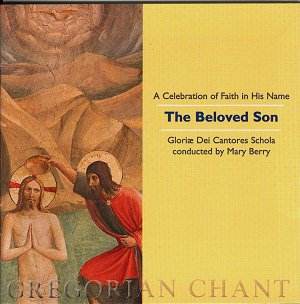I must confess that I have not always been enthusiastic
about Gloriae Dei Cantoresí records in the past. Here, as on their
Christmas CD 'The Coming of Christ' their Schola is directed by
Dr. Mary Berry in a programme themed around the Life of Christ.
On this recording, the sound engineers have managed to strike
the right balance between clarity and sympathy. On previous recordings,
the group have been recorded rather closely, which brings big
advantages in terms of clarity, but means that the group is extremely
exposed when it comes to lack of unanimity in the vocal line.
But here, while clarity has been preserved, the choir are surrounded
by a sympathetic acoustic which adds to their sound immeasurably.
Under the direction of Dr. Mary Berry they produce a wonderfully
focused and flexible sound.
The 16-person Schola, based in Massachusetts,
sings both the daily Benedictine Offices and the Ordinary and
Propers of the mass. This routine familiarity with chant is a
great advantage and shows through in their commitment to all the
music and the meaning of its text. This latter is important, as
chant is nothing if it is not performed with a feeling for the
meaning of the texts.
Rather than doing a liturgical reconstruction, the group have
assembled the chant based on narrative themes. A previous CD covered
Christ's nativity. This CD starts with his baptism followed by
his journey into the desert with an antiphon to the Benedictus
canticle from Lauds for the First Sunday in Lent. But before the
chant starts, David Chalmers plays Gerald Near's organ paraphrase
of 'Ave Colendas Trinitas'. Near writes much sacred music and
it is good to hear some of it on CD, but no matter how well David
Chalmers plays it, I feel that it sits rather oddly with the remaining
plainchant.
The story then goes through the calling of his
disciples using Propers for the Fest of St. Andrew. His preaching
is represented by two Antiphons from the Common of Saints and
of Apostles and the Communion for the Feast of Corpus Christi
looks forward to the institution of the Eucharist.
The parable of the Wise Virgins is presented
via the Communion chant for the Common of Virgins along with a
parable about the Kingdom of Heaven from the Common of Religious.
The first miracle, the Wedding at Cana, is narrated
in the Communion chant from the Common of both male and female
saints. This is followed by a group of antiphons which presents
further miracles; the final one being the raising of Lazarus from
the Communion chant for the Fifth Sunday in Lent, which prefigures
the Resurrection from the dead of Christ himself.
Halfway through the recital we are brought up
short, by the inclusion of another organ piece by Gerald Near
based on 'O Sacrum Convivium'.
The organ piece is followed by an antiphon and
responsory for the Feast of the Transfiguration. The second half
of the recital thus echoes the revelation of Christ's divinity
at his Baptism from the opening of the recital. A group of antiphons
narrates the events leading up to Passion week, culminating in
the chants sung at the Palm Sunday procession. Chant from holy
week includes the lovely 'Ubi Caritas' along with Christís words
when instituting the Eucharist. This group concludes with the
'Pange Lingua', sung during the Procession to the Altar of Repose,
and finally two chants leading towards Christ's resurrection.
The recital ends, as it began, with another organ
piece. This time, Jean Langlais' organ paraphrase 'Mors et Resurrectio'.
Would that the disc had ended with some chant.
As on previous GDC records, the background to
the chant in the booklet emphasises the text at the expense of
the music, there is little in the way of musical background. The
chant is sung in the modern manner. This is Gregorian chant for
now rather than liturgical archaeology.
The majority of chant on this recording is quite
short, the longest (the 'Pange Lingua') lasting 3.37 and some
is inevitably very short. It would have been more satisfactory
if Dr. Berry could have included one or two rather longer chants.
But the recital has been put together with care and some flair.
The fact that it casts its narrative net over the whole of Christ's
life means that we get a generous selection from the church's
year. This is an imaginative solution to the problem of how to
organise a programme of chant. Under Dr. Mary Berry, Gloriae Dei
Cantores Schola give fine performances resonating with conviction.
Robert Hugill


